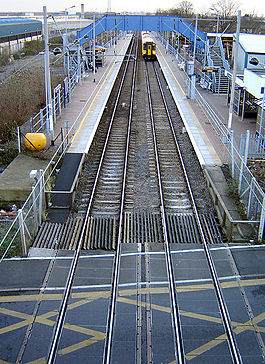Northumberland Park railway station
| Northumberland Park |
|
|---|---|

Northumberland Park station looking south, with level crossing in foreground (February 2006)
|
|
|
Location of Northumberland Park in Greater London
|
|
| Location | Northumberland Park |
| Local authority | London Borough of Haringey |
| Managed by | Abellio Greater Anglia |
| Station code | NUM |
| DfT category | E |
| Number of platforms | 2 |
| Accessible | Yes |
| Fare zone | 3 |
| National Rail annual entry and exit | |
| 2011–12 |
|
| 2012–13 |
|
| 2013–14 |
|
| 2014–15 |
|
| 2015–16 |
|
| Key dates | |
| 1 April 1842 | Opened (Marsh Lane) |
| June 1852 | Renamed (Park) |
| 1 July 1923 | Renamed (Northumberland Park) |
| Other information | |
| Lists of stations | |
| External links | |
| WGS84 | 51°36′06″N 0°03′15″W / 51.6017°N 0.0541°WCoordinates: 51°36′06″N 0°03′15″W / 51.6017°N 0.0541°W |
|
|
|
Northumberland Park railway station is a National Rail passenger station in Northumberland Park, London. The station and all trains serving it are operated by Abellio Greater Anglia.The station is located in London Travelcard Zone 3. The station is immediately south of one of north London's few remaining level crossings. Northumberland Park Depot of London Underground's Victoria line is adjacent to the station. The station is used by Tottenham Hotspur football fans when Tottenham are playing home games at White Hart Lane.
Northumberland Park was opened on 1 April 1842 as a Halt on the Northern & Eastern Railway. The station was originally named Marsh Lane after the country lane to Tottenham Marshes on which it is situated.
The Northern and Eastern Railway was leased by the Eastern Counties Railway in 1844 who took over operation of the line. The line was initially laid to a gauge of 5 ft (1,524 mm) but already this had been identified as non standard and between 5 September and 7 October 1844 the whole network was re-laid to 4 ft 8 1⁄2 in (1,435 mm) standard gauge.
In June 1852 the station was renamed Park station.
The Eastern Counties Railway was taken over by the Great Eastern Railway in 1862.
In 1882 the line through the station became part of a major rail freight artery with the opening of the Great Northern and Great Eastern Joint Railway. This provided a link for the Great Eastern Railway from the coal fields in the north to London. This led to a second pair of running lines known as the Slow Lines (the ones that exist today - 2013 - are the old Fast Lines) being added in 1913.
...
Wikipedia

